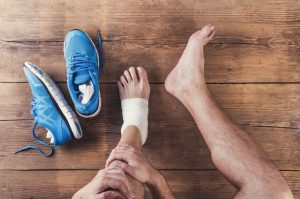We often hear the saying “no pain, no gain,” especially when it comes to working out.
In some ways, this is true. A little bit of pain or tenderness in your muscles can mean that your exercise routine is working for you and your muscles are growing stronger.
But other times, pain is a sign that you may have an injury and should take a break in order to give your body time to heal.
Understanding the source of your pain is not just about safety. By knowing where your pain is coming from, you’ll be able to work out more effectively and efficiently.
And that means faster results.
Signs of “Good” Pain
 The pain most often referred to as “good” pain is known as Delayed Onset Muscle Soreness (DOMS). This often appears a few hours after a training session is complete, but might not show up until the next day.
The pain most often referred to as “good” pain is known as Delayed Onset Muscle Soreness (DOMS). This often appears a few hours after a training session is complete, but might not show up until the next day.
Individuals most frequently experience DOMS when they begin a new workout routine or train a part of their body that hasn’t experienced exercise in a while. This can happen if you begin lifting weights or running after taking a long break from working out.
In addition to the muscle being sore, the affected joint may be stiff and you may have a hard time moving that part of your body. It’s also not uncommon to experience swelling and tenderness in the area.
But while DOMS is usually normal and not something to be alarmed about, pain should only be experienced when muscles are utilized for the first time in your workout or trained more intensely.
Signs of “Bad” Pain
 Many people believe if they aren’t sore the next day, they didn’t get a good workout.
Many people believe if they aren’t sore the next day, they didn’t get a good workout.
The truth is that pain after a workout doesn’t always mean your muscles or growing. It could actually be a sign that an injury occurred.
If you’re feeling sore after a workout, it can be difficult to tell if it’s DOMS or something more serious. Here are a few things to keep in mind:
Location: A good way to determine if your pain is normal is to consider its location. If you worked out your arms and only one arm is hurting, then it is probably a sign of an injury. If you were experiencing DOMS, it would likely appear in all the new areas that were involved in your workout (such as both arms). Unfortunately, this is not always the case.
Workout history: If the area that is in pain is one that you’ve been working out before, it is more likely to be an injury than DOMS. Remember, DOMS only appears when exercise is introduced to a new area of the body.
Physical signs: Extreme swelling or tenderness is also a clear sign that something is wrong. While DOMS can cause slight swelling and tenderness, it shouldn’t be extremely noticeable. Also, if you feel that a tendon is swollen and in pain, it could be a sign of tendinitis.
Severe pain: Sometimes you may experience severe pain during a workout, rather than the soreness associated with DOMS. If you hurt yourself playing a sport – such as an injury that results from an impact, accident or trauma – it is best to assume that your pain is not normal. Serious side effects can occur with severe pain, including numbness, bruising, and burst blood vessels. Each of these consequences should not be ignored.
What to Do If You Feel Pain
 As mentioned before, not all pain is bad for you.
As mentioned before, not all pain is bad for you.
If your pain is associated with DOMS, then it is a sign that your workout plan is taking effect and you will begin to see improvements in your muscles soon.
To relieve pain from DOMS, there are many things you can do, such as:
- Add a high-quality recovery shake to your post-workout routine. BCAAs, carbs, and creatine are all examples of essential ingredients that play a vital part in your muscle’s recovery process.
- Improve your cool-down routine. Many athletes look to yoga to speed up muscle recovery and related injuries.
If you experience pain after your workout, pay attention to the pain and how long it takes to go away.
If you are suspicious that your pain is the result of an injury or otherwise associated with bad pain, don’t power through it. Continuing to work out while in pain can be very bad for the affected muscles, tendons and ligaments. You can make the injury worse, which will keep you from exercising for even longer.
Instead of pushing through pain, try this:
- Take a break from exercising and rest the area in pain.
- Change your plan to accommodate a different area of the body or add a low-impact workout like yoga.
- Reduce the amount of stress put on the injured area, to give it time to heal and get you back in the game more quickly.
- Get medical help. The sooner you have an injury checked by a professional, the faster you will heal.
“No pain, no gain” are still good words to live by. But that also means being able to tell “good” pain from “bad” pain, and taking steps to help your body recover or heal.
Only by knowing the difference between these two will you be able to continue taking your workout to the next level.







